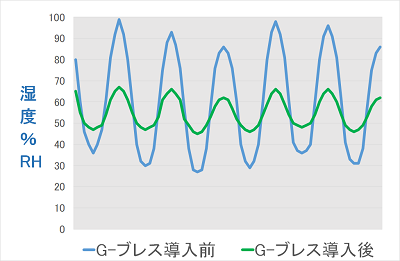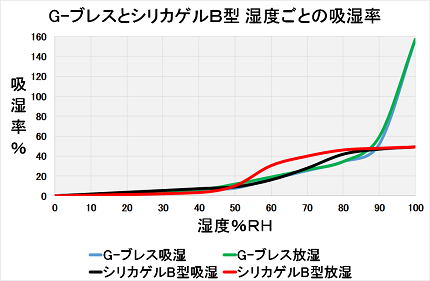We introduce frequently asked questions about the anti-condensation sheet "Humidity Control Sheet".
-
About purchasing (agency, estimate, price, delivery date, size...)
-
Characteristics (mechanism of moisture absorption and desorption, difference from silica gel...)
-
How to use (front and back, number calculation, installation method...)
-
Condensation causes (condensation inside the waterproof box, air vents, etc.)
-
Storage method (precautions for storage)
1. Purchasing
|
Q1-1 : Where can I purchase it? "Would you like to know the estimate, price, and delivery date?" |
| A1-1 |
Humidity Control Sheet will be purchased from an agency.
Domestic: A list of distributors is posted on the purchasing page.
Overseas: We will introduce distributors, so please contact us individually.
* Quotations, prices, and delivery times will also be answered by the agent.
Purchasing (list of domestic distributors)
|
2. Characteristics
|
Q2-1: Why does it absorb and release moisture? |
| A2-1 |
Humidity Control Sheet has the property of trying to balance the amount of water vapor in the surroundings and the amount of water in the G-Breath itself. As the ambient humidity rises (increase in the amount of water vapor), the Humidity Control Sheet absorbs moisture and suppresses the increase in humidity.
Conversely, when the ambient humidity drops (the amount of water vapor decreases), the Humidity Control Sheet the absorbed water vapor into the air, suppressing the humidity drop. As a result, the up-and-down fluctuation of humidity is small.
The graph is an image and not a guaranteed value.
|
|
Q2-2 : Does it absorb more moisture than silica gel type A (does not release moisture)? |
| A2-2 |
Humidity Control Sheet can absorb more moisture than silica gel type A.
Silica gel type A has fine pores and has a structure that absorbs water vapor in the air, and the amount of moisture absorption can only be 30 to 40% of its own weight. Humidity Control Sheet can absorb approximately 160% of its own weight.
Note that the amount of moisture absorption is not a guaranteed value. |
|
Q2-3 : What is the difference between silica gel type B (which absorbs and desorbs moisture) and other moisture-absorbing and desorbing materials? |
| A2-3 |
・ Humidity Control Sheet has a higher moisture absorption rate than silica gel B type at high humidity where the risk of failure of electronic equipment is higher, and it can suppress high humidity inside the equipment.
・ Humidity Control Sheet has higher moisture release than silica gel B type and recovers moisture absorption easily, there is no need to dry in the sun or release moisture at high temperatures.
Moisture absorption rate is not a guaranteed value.
|
|
Q2-4 : Will it freeze at 0℃ and become unusable? |
| A2-4 |
Humidity Control Sheet does not freeze at 0°C.
Even if it is left in an environment of -30°C and then returned to normal temperature, there is no significant change in moisture absorption and desorption performance.
Please note that these are the evaluation results of arbitrary samples, so please make evaluation judgments in the customer's environment. |
|
Q2-5 : What is the basis for long-term use without replacement? |
| A2-5 |
We have confirmed that Humidity Control Sheet maintains its moisture absorption and desorption properties even after an independent accelerated deterioration test equivalent to 10 years at an infrastructure company.
In addition, as a result of collecting and evaluating the product about 10 years after its introduction, it was confirmed that the initial moisture absorption and desorption characteristics were maintained.
Note that the usable period varies depending on environmental conditions and is not a guaranteed value. Replacement may be required depending on the facility structure and environmental conditions such as constant high humidity. |
|
Q2-6: Will the size increase when moisture is absorbed? |
| A2-6 |
Even if Humidity Control Sheet absorbs moisture, its vertical and horizontal size will not change, but its thickness may double. |
|
Q2-7 : Are there flame-retardant products? |
| A2-7 |
Humidity Control Sheet can also be partially flame-retardant, so please contact us.
Catalog products are not UL94V0 standard.
|
|
Q2-8 : Is there a way to check the effect? |
| A2-8 |
Install the device for which you want to check the effect of Humidity Control Sheet in the actual installation location, install a temperature/humidity logger inside the device, and check the difference in temperature and humidity inside the device depending on whether or not Humidity Control Sheet is attached.
The effect can also be confirmed in a simulated environment using a constant temperature bath.
If the humidity fluctuation with Humidity Control Sheet is less than without it, the Humidity Control Sheet is effective. |
|
Q2-9: What is the operating temperature range? |
| A2-9 |
After a temperature cycle test of -30°C to 70°C, Humidity Control Sheet was evaluated for moisture absorption and release, and it was confirmed that there was no change from the initial state. Please note that these are the evaluation results of arbitrary samples, so please make evaluation judgments in the customer's environment. |
|
Q2-10 : Does the humidity decrease as the Humidity Control Sheet increases? |
|
A2-10 |
By increasing the Humidity Control Sheet, the fluctuation range of humidity becomes smaller. Since it is a humidity control material, it can be used as a dehumidifier or desiccant if you want to lower the humidity to 10% or less unlike a desiccant. |
|
Q2-11 : Is it an insulating material? |
|
A2-11 |
Humidity Control Sheet exterior is an insulating material. |
|
Q2-12 : Is it made of environmentally friendly materials? |
|
A2-12 |
Humidity Control Sheet satisfies RoHS Directive and NTT Green Procurement.
After applying from the
RoHS compliant product information request form, we will send a "RoHS compliant product information download" email to your registered email address. |
|
Q2-13 : Does it expand when water is applied? |
|
A2-13 |
Humidity Control Sheet has a structure that absorbs and desorbs only water vapor without allowing water droplets to pass through. Unlike other companies' products, it is designed to be safe so that it will not suddenly expand or explode even if it is directly splashed with water. However, do not install it in an environment that is submerged in water or permanently exposed to water. |
|
Q2-14 : Does the absorbed moisture ooze out? |
|
A2-14 |
Moisture absorbed by G-Breath does not ooze even if the product is pressurized. |
|
Q2-15 : Does it generate heat when it absorbs moisture? |
|
A2-15 |
Humidity Control Sheet does not generate heat. |
3. How to use
|
Q3-1 : Are there front and back sides? |
| A3-1 |
Humidity Control Sheet has no front or back. |
|
Q3-2 : Is there a way to calculate the number of installations? |
| A3-2 |
The volume value in the Humidity Control Sheet catalog is a guideline calculated from the amount of saturated water vapor at a temperature of 0 to 30°C in a closed space.
If you know the maximum and minimum temperature and humidity of the actual usage environment, you can first calculate the number of Humidity Control Sheet installations corresponding to the volume, so please contact your sales agent or contact us.
Based on the standard, the customer decides the size and number of sheets in the actual environment or in an evaluation test that assumes the actual environment.
Depending on the actual usage environment, even with a waterproof structure, air (including water vapor) may flow in and out, and the number of installed Humidity Control Sheet may increase or decrease.
|
|
Q3-3 : What if there is no space to install the L size? |
| A3-3 |
If the number of Humidity Control Sheet installations is calculated as 1 L size, it is also possible to install 16 postcard size pieces. |
|
Q3-4 : How to install? |
| A3-4 |
Humidity Control Sheet is usually installed on the inner wall surface of the equipment, etc., with double-sided tape, magic tape, etc., prepared by the customer.
It is also possible to bend and install the Humidity Control Sheet in the gap of the equipment.
Customers are requested to select double-sided tape, etc., that is suitable for the material of the attachment surface and the installation environment.
Customers may also design their own ventilation pockets for installing Humidity Control Sheet within the equipment. |
|
Q3-5 : Can it be used repeatedly? |
| A3-5 |
Humidity Control Sheet can be used repeatedly. |
|
Q3-6 : What kind of devices are applicable? |
| A3-6 |
The application environment of Humidity Control Sheet is assumed to be in a closed space. |
|
Q3-7 : There are gaps and holes in the applicable device. Are there any precautions? |
| A3-7 |
Humidity Control Sheet works best in a closed space, so close any gaps or holes as much as possible.
If there are gaps or holes, air will flow in and out, and moisture will be absorbed in excess of the design volume. Intrusion of rainwater and snow can also result in a constantly humid environment.
<Proposal>
(1) Seal gaps and holes with caulking material as much as possible.
(2) If it is difficult to seal the air holes as a heat countermeasure, there are cases where we improve the structure to prevent water droplets from entering only the part where we want to prevent condensation, and insert a Humidity Control Sheet in that part as a countermeasure.
* Regarding countermeasures such as air sealing, customers are requested to confirm that there is no effect on equipment before implementing them. |
|
Q3-8 : Can it be cut and used? |
| A3-8 |
Humidity Control Sheet cannot be cut and used. |
4. Causes of condensation
Q4-1 : Condensation has occurred on a product with a waterproof structure that meets the waterproof standard IP◯◯ (eg IP67).
Does condensation occur even in waterproof products? |
| A4-1 |
Even with a waterproof structure, as the air inside cools, the humidity rises, and if the temperature drops below the dew point, condensation will form. |
|
Q4-2 : I installed an air vent as a countermeasure against condensation inside the equipment, but condensation occurred. What is the cause? |
| A4-2 |
As the outside temperature rises, the air inside the equipment also warms up and expands. At this time, ventilation is possible because the internal air is discharged to the outside. On the contrary, the internal air contracts as it cools.
During contraction, a negative pressure acts inside the device, allowing outside air to enter. If the external humidity is high, high-humidity air will enter, and condensation will occur when the air is cooled. |
5. Storage method
|
Q5-1 : Are there any precautions for storage? |
| A5-1 |
When storing the Humidity Control Sheet, store it in an unopened zippered plastic bag in a cool indoor environment away from direct sunlight. |




 close up
close up